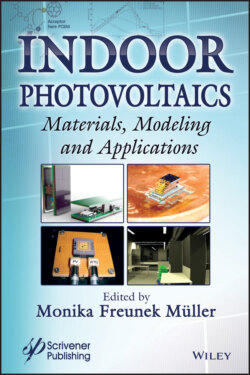Читать книгу Indoor Photovoltaics - Группа авторов - Страница 44
3.5 Degradation and Lifetime Issues
ОглавлениеDegradation effects decrease the efficiency over time, thus limit the lifetime among other effects. As most degradation effects are related to energy and intensity levels, indoor conditions are again in favor of the photovoltaic materials. The Stabler-Wronski-Effect in a:Si:H is related to intensity [38], so a:Si:H can expect a longer lifetime indoors than in outdoor operation. As the first generations of outdoor systems start to report lifetimes above three decades, for most materials the photovoltaic module will not be the limiting device for the total device lifetime in IoT edge nodes.
However, so far, few studies have been reported investigating the lifetime for IPV products. In a study from 2013, photodiodes from GaAsP and organic solar cells (P3HT:PCBM) were irradiated by fluorescent light for 3900 hours [39]. This would be approximately 2.3 years of use in an office with 222 working days per year and 8 hours of artificial irradiance per day. The organic cells degraded about 15% from their initial efficiency, the GaAsP about 10%. As these devices might be installed for a long time, degradation issues need to be addressed during design.
A second topic in product design is recycling and toxicity. As IoT devices are small, they might be forgotten in their installations or be integrated into building structure and furniture. Easy removal and recycling and avoidance or handling of toxicity is thus important during early design. Finally, the total cost of ownership and the CO2 footprint of those devices need to be addressed over the whole production chain and life cycle. Reinders and Apostolou provided an overview of product integrated PV, including IPV and outdoor applications, such as in cars [40]. Chapter 8 introduces current IPV product integration.
